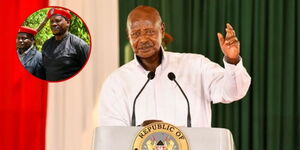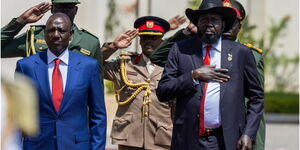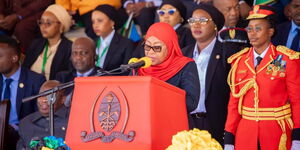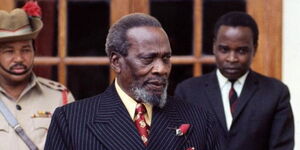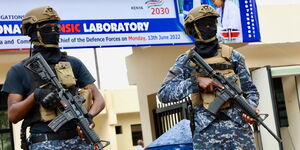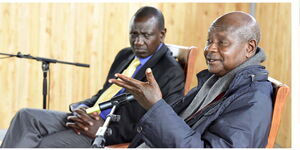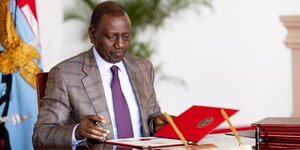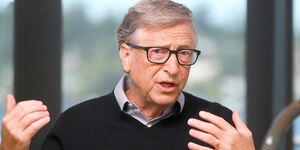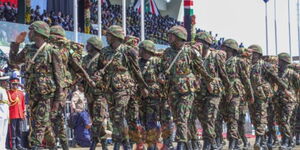If anything is to go by, 2018 is the perfect embodiment of the layman’s phrase,’ A lot could happen in one year.’
What began as a politically tense year that left many Kenyans worried about the future of Kenya has ended up, in an interesting turn of events, to be the year that will arguably go down in history as one that reunited Kenyans from the inter-tribal strife that has been building up for years.
In 2018, conflicts that had been carried over through the generation were amended, sworn enemies who couldn't see eye to eye before hugged, new political unions in preparation for 2022 were formed, while the untouchables were arraigned in court for their involvement in graft scandals.
Kenyans.co.ke reviewed the year in retrospect to compile a compelling report on the 10 major occurrences that shifted the political landscape in Kenya.
1. The Handshake
When the year began, President Uhuru Kenyatta and ODM leader Raila Odinga were sworn enemies, having carried a generational dispute that dated back to the era when their late fathers were the faces of politics in Kenya. This dispute, which was backed by the allegiances from the members of their respective communities, had threatened to tear the country into two, with Raila even making a daring move to swear himself in as the people’s President, dissatisfied with the results of the 2017 presidential election.
On March 9, 2018, after months of dragging each other in the mud, name-calling and endless wrangles that saw the death of several Kenyans, the two leaders stood side by side and shook hands as the world witnessed them pledging to bury their hatchet. The reconciliation, which was to be later christened as the Handshake, was infectious. With the two pledging to work together, political leaders under the umbrella of the two dynasties also followed suit, shaking hands and promising to promote the unity agenda.
Kenyans were relieved. They had grown tired of the constant warring and just wanted an environment that would favor their businesses and ensure their safety.
The handshake was the first step to the revolution of what is now the current state of politics in Kenya. It was the handshake that gave birth to the building bridges Initiative.
2. The Building Bridges Initiative
After the handshake, it was important to solidify the newly formed relationship between the two principals. The Building Bridges Initiative was birthed as the vehicle that would oversee the mending of the rifts that had taken precedence in Kenya, and pave way for a new nation, with lasting unity as the main agenda.
A 14-member task force to oversee the initiative was gazetted on May 31, 2018, and was mandated with evaluating the national challenges outlined in the Joint Communique of 'Building Bridges to a New Kenyan Nation and then making practical recommendations and reform proposals to build lasting unity.
To do this, they were required to make tours around counties seeking the people’s views on how to implement its agenda.
3. Uhuru’s Kisumu Tour
Another legendary event in 2018 was Uhuru’s tour to Kisumu to Launch the Universal Health Coverage ( UHC) Pilot program. Being Raila’s backdrop, the ODM leader welcomed and ushered in the president, even inviting Uhuru to his Bondo home.
During his tour, Raila was received by a rather excited crowd who were impressed by the new found relationship between the two principals.
The tour also portrayed an interesting twist that would see a major shift in future politics, promising possible partnerships in 2022. Uhuru, in his address to Kisumu residents, hinted at a possible referendum that would ensure that no party would be left out in government. This, the president argued, would put an end to the incessant wrangles that were constantly witnessed after the elections.
The president also held a closed-door meeting with the Luo legislators. It was alleged that in the meeting, the leaders from the lakeside offered to support the president’s referendum bid if Uhuru promised to support Raila for the presidency in 2022. In return, President Uhuru would be guaranteed to get the Prime Minister’s position that would be created in the referendum.
4. Raila’s Appointment to the AU
The perks of the handshake for Odinga were evident after he was appointed to The African Union Envoy as the High Representative for Infrastructure Development in Africa. In his new job, Raila is the highest ranking special envoy to the African Union chairman, with offices in five countries.
While it was a win for Raila, his counterparts eyeing the 2022 presidential position hope that the AU job, being a permanent position would keep him less interested in succession politics. His Appointment to the AU also came in line with Odinga claiming that he was working closely with President Uhuru on matters government, with Uhuru consulting him on important decisions.
While President Uhuru and Raila mended their relationship, other politicians with DP Ruto being a major victim, were not as lucky as their supporters’ loyalty was tested and proved to be weak against the sands of time. Listed below are some occurrences that saw Kenyans witness shifting allegiances.
5. President Uhuru’s Tanga-tanga statement
This was the first indication of possible cracks in the Jubilee party. It was the first time that Kenyans witnessed the two, President Kenyatta and DP William Ruto, who had all along portrayed a strong bond, call out each other in public.
“Hii kijana anaitwa Ruto unajua kila wikendi anatangatanga kila pahali. Atakuwa anapitia hizi machochoro.(This young man called Ruto, you know he likes roaming everywhere every weekend. He will be encompassing these routes,) Uhuru told Kenyans.
“Akiona kitu inaenda konakona mmwambie. Tuhakikishe kazi ya wananchi imefanyika (If he sees anything that’s not going well, tell him. We have to make sure citizen duties are fulfilled),” he continued.
In his statement, Uhuru was seemingly calling out Ruto for his frequent trips to harambees and churches around the country.
To counter the President, Ruto launched the Tanga-tanga Movement and during an event the two later attended together, the DP, on a light note, thanked his boss for the permission to move around.
Some Jubilee legislators who were Ruto’s supporters, however, did not take the president’s statement lightly, causing some tension within the party, with team Ruto crying foul.
6. The rift among DP Ruto’s Rift valley counterparts
Another setback that DP Ruto had to outmaneuver were the evident rifts among leaders from his political stronghold, Rift valley. While the DP managed to bring his sworn foe former Bomet Governor Isaac Ruto and his CCM Party to his side, a section of legislators from Rift Valley, were quick to make their stand against the DP known.
Some, like Nandi Hills MP Alfred Keter, Moiben MP Silas Tiren and Cherangany lawmaker Joshua Kutuny, linking the DP and his allies to the cartels that were messing up the maize sector.
"We want to tell the DP that we know the problems and cartels frustrating farmers are directly linked to him and his office. That’s why we want all leaders probed. We are also ready to be probed," Keter pointed out.
7. Referendum talks
Talks of going back to the ballot to vote for a new referendum have been underway throughout 2018 and were received both positively and negatively, in equal measure.
With President Uhuru clearly in support of the referendum, he hinted on the issue a couple of times during his public addresses to Kenyans. After the handshake, it was a common denominator uniting the ODM leader with Uhuru’s supporters. Both sides argued that this would be the only way to put out the years-long scuffles that occurred every time Kenyans went for elections.
However, DP Ruto’s supporters expressed their displeasure on the issue. They argued that the referendum was an attempt to lock out Ruto from the 2022 Presidential Election.
8. Kieleweke slogan
The song by Kikuyu musician Kimani wa Turacco, which was well received from the Central region, was a clear indication that the area residents, who had pledged to vote for Ruto come 2022, were shifting allegiances. It became the 2018 slogan to let DP Ruto know that the central region was not indebted to him and therefore, would vote for whoever they pleased come 2022.
Vocal leaders from Mt Kenya reiterated the slogan speaking to local media on August 21, 2018, Kiambu Senator Kimani Wamatangi noted that in 2022, voting would not be based on paying political debts but on the nature of services a leader has delivered.
"Kenyans have moved away from such parameters and will no longer be made to vote on debt lines or pay supposed political debts," Wamatangi noted.
9. Major political Figures Visiting Mzee Moi
In 2018, major political figures flocked former President Daniel Toroitich Arap Moi’s home. Most people believe that the visits orchestrated possible political collaborations in preparation for the 2022 presidential elections.
Almost every candidate who had expressed an interest in vying for the presidency in 2022 took a quick trip to Kabarak to pay their respect to the former head of state. They include President Uhuru, ODM leader Raila Odinga, Kalonzo Musyoka, Cotu boss Francis Atwoli, Devolution CS Eugene Wamalwa and Mombasa Governor Ali Hassan Joho.
However, attempts by DP Ruto to visit Mzee Moi were thwarted. As alleged, this was owed to the fact that there was a rivalry between Ruto and Baringo Senator Gideon Moi, who is also Moi’s son. The rivalry stemmed from their supremacy battles to be crowned the Rift Valley kingpin.
Ruto’s supporters argued that locking DP Ruto out of the visits was an indication that he was clearly being isolated from the 2022 elections.
10. President Uhuru’s stand against corruption.
The biggest win for Kenya was when President Uhuru announced his intent to get rid of the corruption menace which has long ailed the country, threatening its development and economic growth. The president declared that everyone, including his own kin, would carry their own cross if caught up in graft scandals.
This gave the anti-corruption body a boost, with multi-billion corruption scandals, including the NHIF, NYS and the Kenya Pipeline one being unearthed and culprits arraigned in court.
Major public figures, including Migori Governor Okoth Obado and former Nairobi governor Evans Kidero, did not escape the long arm of the law with various being locked up in cells during the DCI’s famous kamata kamata Fridays. Property worth millions of shillings, which had been rendered untouchable despite encroaching on public and riparian land were finally demolished.
The anti-corruption bid didn’t escape politicking, as a section of leaders from Ruto’s backdrop, Rift Valley claimed that the DCI and EACC were unfairly targeting the Kalenjin Community which elicited lots of reactions.

